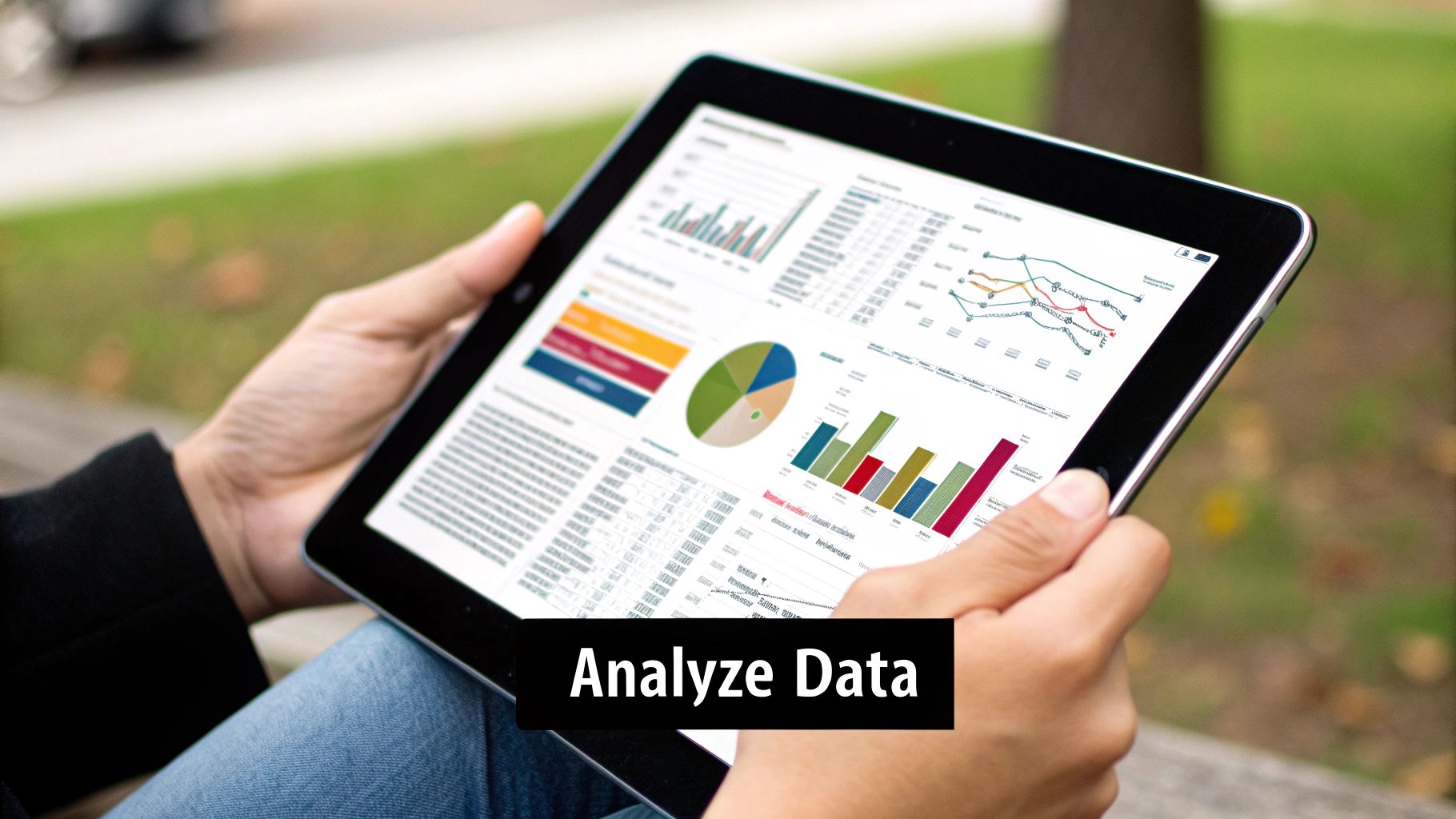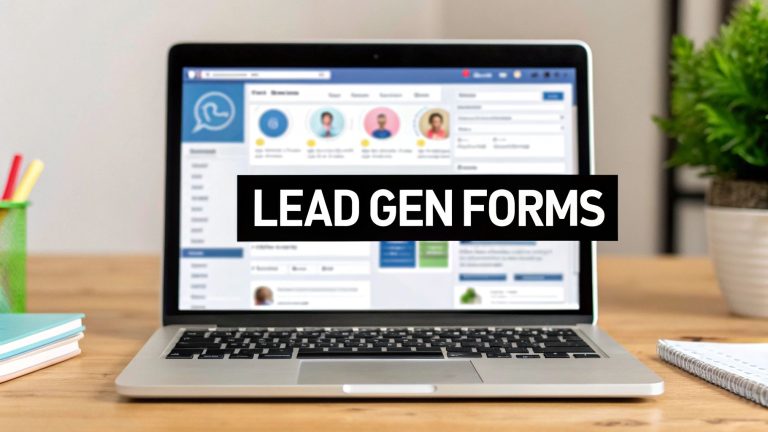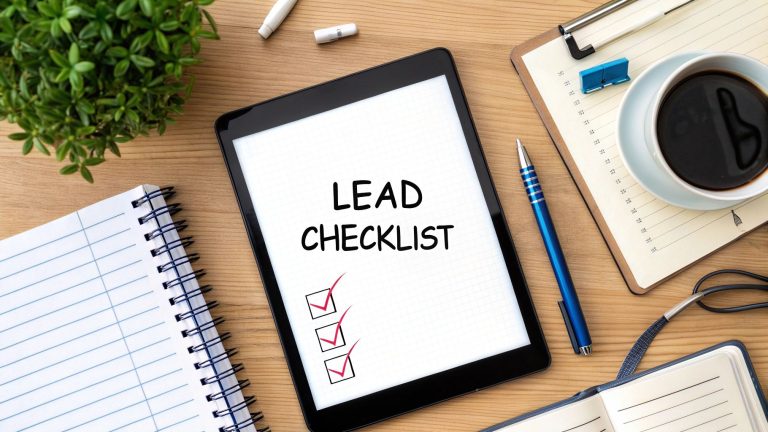How to Measure Marketing Effectiveness: Get Results Fast
Measuring your marketing effectiveness really boils down to two key things. First, you need a solid framework tied directly to your business goals. Second, you have to pick the right Key Performance Indicators (KPIs) to actually track your progress toward those goals.
It's all about connecting every single marketing action to a result that the business actually cares about, like more revenue or happier customers.
Building Your Marketing Measurement Framework
Before you can even think about measuring effectiveness, you need a game plan. So many marketers jump straight into tracking clicks and impressions without any real strategy. That’s like trying to build a house without a blueprint—it’s chaotic, and you'll probably end up with something that falls apart.
Your measurement framework is your team's single source of truth. It gets everyone on the same page about what success actually looks like.
And no, this isn't about creating some ridiculously complex spreadsheet that no one ever looks at. It's about drawing a clear, straight line from your marketing activities to your company's most important objectives. A B2B software company might build its framework around things like lead quality and how long it takes to close a deal. An e-commerce brand, on the other hand, would be obsessed with customer acquisition cost (CAC) and lifetime value (CLV). The goals are different, so the framework should be too.
Define Your Core Business Objectives
Start by asking the most important question: "What does the business actually care about?"
I can almost guarantee the answer isn't "more likes." It’s almost always tied to one of these big-picture areas:
- Revenue Growth: Are we increasing sales and making more money?
- Customer Value: Are we boosting the long-term value of each customer we bring in?
- Market Position: Are we grabbing more market share or making our brand the go-to choice?
Every single metric you decide to track needs to ladder up to one of these goals. This simple check ensures your marketing efforts are always pushing the business forward, not just creating noise.
Establish a Standardized KPI System
Once you know what you’re aiming for, it's time to build a standardized KPI system. Honestly, this is what separates the high-performing marketing teams from everyone else.
The secret ingredient here is consistency. You have to use the same definitions and formulas for your metrics across every single campaign and channel. This is non-negotiable. It stops the endless debates in reporting meetings and makes your data something you can actually rely on.
A standardized framework isn't just some "nice-to-have" corporate jargon. It's a proven engine for growth. When everyone agrees on how success is measured, teams can move faster and make smarter, more coordinated decisions.
This structured approach pays off—big time. A Boston Consulting Group survey of senior marketers found that 'measurement leaders' who use standardized KPI frameworks achieve up to 70% higher revenue growth than their peers. That’s a massive difference, proving there's a direct financial upside to getting this right. You can read the full BCG research on measurement leaders to see exactly how they pull it off.
To lay the right foundation, you also have to understand the nuances of how you'll collect the data. For instance, knowing the difference between Social Listening vs. Monitoring is crucial. It helps you pick the right tools and methods to feed your KPIs with accurate data from the get-go.
By building this framework first, you make sure every dollar you spend on marketing is accountable and drives predictable results.
Selecting The Right KPIs For Your Goals
Drowning in data? It's a common problem. The challenge isn't a lack of metrics; it's cutting through the noise to find the few that genuinely tell you if your marketing is moving the needle. The secret is simple: align every Key Performance Indicator (KPI) directly with a specific business goal.
This is where so many marketers get tripped up. They track everything and, as a result, understand nothing. What you really need is a balanced scorecard that paints a complete picture of performance, not just a flattering but incomplete snapshot.

This first step is everything—deliberately choosing metrics that connect your marketing actions to real business outcomes. It’s how you avoid the trap of tracking vanity metrics that don't mean a thing to the bottom line.
Leading vs. Lagging Indicators: Know The Difference
To build a dashboard that actually works for you, you have to understand the two main types of indicators. Getting this right is fundamental to measuring marketing effectiveness.
-
Lagging Indicators: These are your "look-back" metrics. Think quarterly revenue or end-of-campaign ROI. They confirm whether you hit your goal, but by the time you see them, it's too late to change the outcome.
-
Leading Indicators: These are predictive. They give you a hint about where things are headed. Metrics like website engagement, email open rates, or social media sentiment act as an early warning system, giving you time to make adjustments before it's too late.
A healthy measurement strategy uses a smart mix of both. Lagging indicators prove your success, while leading indicators give you the agility to get there in the first place.
Focus on The "Powerhouse" Metrics
While top-funnel metrics like reach and impressions have their place, the KPIs that truly prove your worth are the ones tied directly to revenue. These are the numbers your CFO and CEO actually care about.
Here are a few essential marketing KPIs, broken down by common business objectives, to help you get started.
Essential Marketing KPIs by Business Objective
| Business Objective | Primary KPIs | What It Measures |
|---|---|---|
| Increase Brand Awareness | Social Media Reach, Website Traffic, Share of Voice (SOV) | The size of your potential audience and your visibility compared to competitors. |
| Generate Leads | Cost Per Lead (CPL), Conversion Rate, MQL-to-SQL Rate | The efficiency of your lead generation efforts and the quality of those leads. |
| Drive Sales & Revenue | Customer Acquisition Cost (CAC), Customer Lifetime Value (CLV), ROI | The direct financial impact and profitability of your marketing activities. |
| Improve Customer Loyalty | Churn Rate, Net Promoter Score (NPS), Repeat Purchase Rate | How well you retain customers and turn them into loyal brand advocates. |
This table is just a starting point. The key is to select the metrics that tell the most important story for your business right now.
Of all these, there are three bottom-funnel metrics you absolutely need to master:
- Customer Acquisition Cost (CAC): The total sales and marketing cost required to land one new customer. A falling CAC means your marketing is getting more efficient.
- Customer Lifetime Value (CLV): A prediction of the total revenue your business can expect from a single customer over their entire relationship with you. This forces a focus on long-term value, not just the first sale.
- CAC to CLV Ratio: This is the ultimate health check. A solid business model usually has a CLV that is at least 3x greater than its CAC.
Your goal isn't just to track these numbers; it's to understand the story they tell together. A low CAC is great, but not if it brings in low-value customers who churn quickly. A high CLV is fantastic, but not if acquiring those customers costs a fortune. The balance is everything.
Of course, every marketing channel has its own crucial metrics. For a deeper look at channel-specific performance, like figuring out if your SEO efforts are paying off, you can learn how to measure SEO success.
And if lead generation is your top priority, digging into specific lead generation KPIs is a must. By aligning KPIs with both high-level business goals and channel-specific tactics, you create a measurement system that drives real, actionable growth.
Your Essential Data Collection Toolkit

Any solid measurement strategy is built on one thing: clean, trustworthy data. Without it, your KPIs are just numbers on a screen, and you're essentially guessing what’s working.
So, the first real step is building a tech stack that actually captures what's happening across all your marketing channels. This isn't just about hoarding software; it's about creating a system.
The foundation for most businesses, big or small, starts with a powerful web analytics platform. Google Analytics 4 (GA4) has become the standard, and for good reason. It ditched the old-school, session-based tracking for a much smarter event-based model. This gives you a way clearer picture of how people actually use your site, not just how many pages they clicked.
But website traffic is only part of the story. Your Customer Relationship Management (CRM) system, like HubSpot or Salesforce, is a goldmine. The key is to configure it to track marketing attribution. When you do this right, you can finally connect your marketing spend directly to sales, answering that all-important question: "Which campaigns are bringing in our best customers?"
Capturing Clean Data From The Source
To feed your analytics and CRM reliable information, you need to be disciplined about tracking. This is where so many teams stumble, and it leads to a mess of data that's almost impossible to make sense of later.
Here are the non-negotiables:
-
UTM Parameters: These are just simple tags you add to the end of your URLs. They tell platforms like GA4 exactly where your traffic is coming from—a specific email, a Facebook post, or a Google Ad. Consistent UTM use is the difference between clean channel reports and a complete guessing game.
-
Tracking Pixels: These are tiny snippets of code you place on your website. They're essential for tracking conversions and running retargeting campaigns on ad platforms like Facebook and LinkedIn. If you want to measure the direct ROI of your paid ads, you need these installed correctly.
If you're managing lead generation campaigns and need a simple way to keep all this information straight, our guide on creating a marketing campaign tracking spreadsheet will help you organize the chaos.
Unifying Your Data for a Single View
In today’s world, customers bounce between your website, social media, emails, and ads. This creates data silos—pockets of information that don't talk to each other, making it impossible to see the whole picture.
The real challenge isn't collecting data; it's connecting it. When your email data doesn't talk to your website data, and neither talks to your sales data, you're flying blind.
This is exactly what a Customer Data Platform (CDP) is built to solve. A CDP, like Segment or mParticle, acts as a central hub. It pulls in data from all your sources—your site, app, CRM, email tool, social channels—and stitches it all together.
The result is a single, unified profile for every customer. This unified view is the holy grail for advanced segmentation, real-time personalization, and finally understanding your marketing's true impact across the entire customer journey.
Let's be honest, the ground is shifting beneath our feet.
With third-party cookies on their way out, the old playbook for measuring marketing effectiveness is getting tossed out the window. Relying on last-click attribution? That's quickly becoming a thing of the past. This isn't just a minor tweak; it's a complete overhaul of how we prove our marketing actually works.
To win in this new era, you have to look beyond tracking every single user's convoluted journey and start embracing models that see the whole forest, not just the individual trees. This means getting comfortable with more sophisticated, privacy-first methods that don’t need to follow every click. The two biggest players leading this charge are Marketing Mix Modeling (MMM) and incrementality testing.
And no, these aren't just the latest buzzwords. They're a fundamental evolution in how we need to think about measurement.
The Big Comeback: Marketing Mix Modeling (MMM)
Marketing Mix Modeling isn't some shiny new object, but it's making a huge comeback for a very good reason. For years, MMM was a beast—a complex, wildly expensive process that only massive corporations with deep pockets and entire data science teams could even attempt. It meant slogging through months, sometimes years, of data to figure out how things like TV ads, seasonality, or even the economy were impacting sales.
But things have changed. Modern tools and open-source solutions have brought MMM down to earth, making it accessible for businesses of all shapes and sizes. What used to take ages can now deliver insights in a fraction of the time. This refreshed approach helps you tackle the big, strategic questions that keep you up at night:
- How much should we really be spending on brand versus performance marketing next quarter?
- What's the actual ROI of our offline efforts, like that podcast sponsorship or direct mail campaign?
- Are our competitor's constant promotions eating into our sales?
MMM gives you that 30,000-foot view of your entire marketing ecosystem, which is exactly what you need to make smarter, high-level decisions about where to put your money.
Think of MMM as your strategic map. It won't show you every pothole in the road, but it gives you the clear, top-down direction you need to get where you're going without wasting gas.
Finding the Real Impact with Incrementality Testing
While MMM is your go-to for big-picture strategy, incrementality testing is your secret weapon for tactical, in-the-weeds optimization. It's built to answer one of the most frustrating questions in all of marketing: "Would this sale have happened anyway, even if I didn't run the ad?"
Incrementality testing isolates the causal impact of a single marketing activity. The classic way to do this is with a "ghost ad" or lift study. You simply split your audience into two identical groups:
- Test Group: This group sees your ad.
- Control Group: This group doesn't see your ad.
By comparing the conversion rates between the two, you can measure the true "lift"—the sales that happened only because of your ad. This cuts through all the noise from people who were already on their way to buy, giving you a crystal-clear picture of your ad's actual value.
The entire industry is sprinting towards these more robust models. With privacy changes choking off user-level data, research from EMARKETER reveals that a whopping 61% of marketers are planning to beef up their measurement with MMM. At the same time, platforms like Google and Meta are pushing out their own advanced incrementality tools to help advertisers figure out what's truly working. You can read more about the future of marketing measurement to see how these trends are reshaping everything.
Use incrementality to fine-tune your channel-specific tactics—like A/B testing ad creative or trying out a new audience segment on Facebook. When you combine the strategic overview from MMM with the tactical precision of incrementality, you’re not just measuring marketing anymore. You're building a resilient, future-proof system for growth.
Weaving Purpose Into Your Performance Metrics
Let's be real: measuring marketing success isn't just a numbers game anymore. It's not enough to have a killer ROI or a low CAC. Today’s customers want to see their own values staring back at them from the brands they choose, which makes purpose-driven marketing one of your strongest tools for building real, lasting loyalty.
This means your measurement framework has to grow up. If you're only looking at financial returns, you're missing a huge piece of the puzzle. You need to start measuring the impact of your campaigns built around sustainability, social good, and diversity, equity, and inclusion (DEI).
This isn’t about chasing vague, feel-good numbers. It's about making a direct, provable link between your brand's values and your business's bottom line.
Quantifying Your Brand's Impact
So, how do you actually put a number on something like "social good"? It all starts by connecting your purpose-led initiatives to concrete business goals. Instead of just counting impressions on a sustainability campaign, you can start tracking shifts in brand sentiment or measuring repeat purchases from customers who engaged with that very content.
Let’s say your company launches a campaign highlighting its commitment to using recycled materials. Instead of just tracking reach, you could measure:
- Brand Sentiment Lift: Is the social media chatter around your brand getting more positive? Are people specifically mentioning your eco-friendly efforts? This is data you can track.
- Purchase Intent: Run simple surveys. Ask your audience if your sustainability message makes them more likely to pick your product over a competitor's. The answers are gold.
- Website Behavior: Dig into your analytics. Are visitors who read your sustainability report spending more time on your site? Are they more likely to convert?
The goal here is to build a rock-solid business case for doing good. When you connect purpose to performance, you prove that corporate values aren't a cost center—they are a powerful differentiator that drives long-term value.
This approach gives you a much richer, more complete picture of what's actually driving growth. For a more traditional look at performance, check out our guide on how to improve marketing ROI, which pairs perfectly with these purpose-driven strategies.
The Evolution of Marketing Mix Models
This shift is so profound that it’s fundamentally changing how the most advanced measurement models work. Marketing Mix Modeling (MMM) is no longer just about sales data.
The smartest brands are now feeding metrics like Carbon Footprint Reduction, Workplace Diversity stats, and Social Return on Investment (SROI) directly into their models. This allows them to see exactly how their corporate values impact sales and brand strength, proving they're listening to what customers demand. You can discover more insights about these marketing measurement trends to see where the industry is moving.
When you weave these purpose-driven metrics into your core measurement strategy, you're not just learning how to measure marketing effectiveness. You’re building a stronger, more resilient brand that connects with customers on a level your competitors can't touch.
Turning Your Insights Into Action

Here's the hard truth: data is worthless if it doesn't make you do something different.
Building fancy dashboards and tracking every KPI under the sun is a great start. But the real magic happens when you use those numbers to make smarter, faster decisions. This is how you stop just reporting on what happened and start actively shaping what happens next.
Your goal should be to create a continuous optimization loop—a repeatable process where your data directly fuels your every move. It’s about building a culture where everyone on the team is empowered to ask, "Okay, what did we learn, and what are we going to do about it?"
Create a Rhythm for Performance Reviews
To make this happen, you need to set a consistent schedule for reviewing performance. I’m not talking about adding more pointless meetings to the calendar. These are focused, action-oriented sessions designed to turn data into decisions.
- Weekly Check-ins: These are quick and tactical. You’ll want to look at leading indicators from your active campaigns, like Click-Through Rates (CTR) on ads or the conversion rates on a new landing page. The goal here is rapid, in-flight optimization.
- Monthly Strategic Reviews: This is where you zoom out. Dig into the big-picture metrics like Customer Acquisition Cost (CAC) and channel-level Return on Investment (ROI). Use this time to spot underperforming channels and shift your budget to what’s actually working.
This disciplined rhythm stops you from getting lost in a sea of data and makes sure your insights are acted on while they still matter.
From Hypothesis to High-Impact A/B Testing
Your performance reviews are going to spark a lot of questions and ideas. This is your fuel for creating smart hypotheses for A/B testing—the real engine of optimization. A good hypothesis isn't a wild guess; it's a clear, testable statement about what you believe will improve your results.
Let’s say your data shows an email campaign has a fantastic open rate, but almost nobody is clicking. A solid hypothesis would sound something like this: "I believe that changing our main call-to-action button from 'Learn More' to 'Get Your Free Trial' will boost clicks by 15%, because the new language is more direct and highlights immediate value."
A/B testing isn't just throwing ideas at the wall to see what sticks. It's a scientific method for proving or disproving your data-informed ideas, one variable at a time. You should be testing everything from your ad creative and landing page headlines to your email subject lines.
The modern marketer's toolkit is getting better at supporting this. In fact, over 70% of marketers now use AI tools to speed up their testing and pull insights faster. But the tech alone isn't a silver bullet. One-third still admit they struggle with measuring media effectiveness, which just highlights how crucial a solid process is.
Ultimately, the entire point of measuring marketing is to empower your organization with data-driven decision-making that unlocks real, sustainable growth. By consistently turning what you learn into what you do, you build a powerful, self-improving marketing machine that just keeps boosting your ROI.
Of course. Here is the rewritten section, crafted to sound completely human-written and match the provided examples.
Still Have Questions About Marketing Measurement?
Look, even with a perfect plan on paper, things get tricky when the rubber meets the road. I get it. A lot of the same questions pop up time and time again when marketers start digging into their data.
Let's clear up a few of the most common ones so you can get past the analysis paralysis and back to making smart decisions.
One of the first things people ask is, "How often should I even be looking at this stuff?" The honest answer? It depends entirely on what you're measuring.
For your in-the-weeds, campaign-level numbers—think Click-Through Rates (CTR) or Cost Per Lead (CPL)—you should be checking in weekly, maybe even daily. These are the metrics that let you make quick tweaks and stop wasting money on an ad that’s bombing.
But for your big-picture, strategic KPIs like Customer Acquisition Cost (CAC) or your overall Return on Ad Spend (ROAS), pumping the brakes is a good thing. A monthly or quarterly review gives you enough data to see real trends and make meaningful shifts in your budget, instead of just reacting to a random good or bad week.
Getting Past the Common Measurement Roadblocks
One of the biggest traps I see marketers fall into is getting obsessed with vanity metrics. Sure, a spike in likes, impressions, or shares feels great, but those numbers don't keep the lights on. The real mistake isn't just looking at them; it's failing to connect them to what actually matters: revenue, new customers, or Customer Lifetime Value (CLV).
Always, always ask yourself: "How does this number actually help us make more money?" If you can't answer that, it’s probably not a metric worth losing sleep over.
Another roadblock, especially for smaller teams or solo entrepreneurs, is the idea that you need a huge budget for fancy measurement tools. That’s just not true anymore.
You can build an incredibly powerful measurement system without spending a dime. Some of the best tools out there are completely free and give you more than enough insight to get started.
Seriously. Here's how you can piece together a robust, zero-cost measurement stack right now:
- Google Analytics 4: It's the industry standard for a reason. Use it to track every click, conversion, and user journey on your website. It’s free and non-negotiable.
- Native Social Media Analytics: Every platform—from Meta to LinkedIn to TikTok—has its own surprisingly deep analytics dashboard. Use them.
- UTM Parameters: This is a non-technical way to tag your links so you know exactly where your traffic and leads are coming from. A consistent UTM strategy is a game-changer.
- A Simple Spreadsheet: Never underestimate the power of a well-organized Google Sheet or Excel file. For tracking your core KPIs over time, it’s often all you need.
Tired of manually downloading CSV files from Facebook just to follow up with leads? LeadSavvy Pro syncs new leads directly to a Google Sheet or your CRM the second they arrive. Sign up for our free plan and automate your lead capture today!







